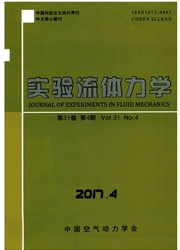

 中文摘要:
中文摘要:
根据美国路易斯安娜州立大学飓风研究中心对古斯塔夫(Gustavo)飓风的实测资料,首先采用传统方法统计出不同高度处强风的基本参数特性,然后运用轮次法对不同高度、时距和起始点的风速样本进行非平稳特性检验,最后基于希尔伯特一黄变换(HHT)方法对于呈现非平稳特性的风速序列进行经验模式分解(EMD)和时一频一谱联合特征分析。分析发现,飓风的湍流强度和积分尺度较良态风场相差较大,并且其平均风速也极不稳定;通过轮次法对不同高度和时段的风速时程检验发现,非平稳特性与高度和统计时段大小密切相关,相应的10min时距的风速样本也存在非平稳特性;HHT对非平稳风速序列分析结果表明,飓风的非平稳特性主要是由时变的平均风速引起,其能量和频率随着时间的变化明显,并且主要能量集中在0.05~0.2Hz频段内,但EMD分解和Hilbert谱结果表明高频能量同样不能忽略。最终得出的结论为:基于传统的分析方法可以很好地获得基于平稳假定的飓风统计参数,但不能获取其非平稳信息,而轮次法和HHT方法是识别非平稳和分析其时频谱联合特性的良好方法。
 英文摘要:
英文摘要:
Based on measuring data for Gustavo hurricane by Hurricane Research Center of Louisiana State University in America, the basic characteristic parameters of strong wind can be got with traditional method at first, then non-stationary characteristics with different height, time distance and origination through Lunci method, at last the HHT method is used to analyse the time frequency-spectrum characteristics and EMD decomposition. It can be found that, turbu- lence intensity and integral scale are bigger than the normal wind characteristics, and the mean wind speed is also unstable. The non-stationary characteristics is closely correlative with height and time distance, and sample of corresponding 10 min appears non-stationary characteristics. The characteristic is caused by the time-variant mean wind speed, its energy and frequency vary with time, and the main energy concentrates upon the frequency band of 0.05~0.2Hz, however, the energy on high frequency band can not also be neglected. Finally the conclusions can be ob- tained that the traditional method can analyse hurricane characteristics based on stationary as- sumption, while Lunci and HHT methods are favorable methods to identify non-stationary char- acteristics and analyse the time-frequency-spectrum characteristics.
 同期刊论文项目
同期刊论文项目
 同项目期刊论文
同项目期刊论文
 Extreme wind pressures and non-Gaussian characteristics for super-large hyperbolic cooling towers co
Extreme wind pressures and non-Gaussian characteristics for super-large hyperbolic cooling towers co Wind-induced responses and equivalent static wind loads of tower-blade coupled large wind turbine sy
Wind-induced responses and equivalent static wind loads of tower-blade coupled large wind turbine sy 期刊信息
期刊信息
